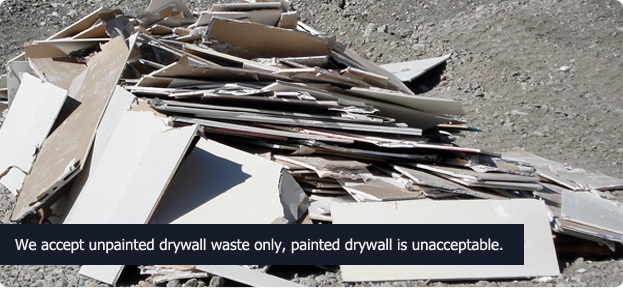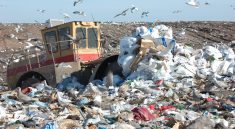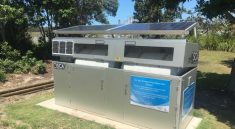Gypsum drywall recycling vs hydrogen sulfide gas production, Most disposed of in landfills, Recycled into new drywall cement soil additive fertilizer
From the Construction & Demolition Recycling Association.
“Drywall Recycling
To give you a basic overview of gypsum drywall recycling, we’ve compiled answers to commonly-asked questions about the process.
What is Gypsum Drywall?
A description of gypsum drywall must first begin with a discussion of gypsum itself. Gypsum, a naturally occuring mineral, is composed of calcium sulfate (CaSO4) and water (H2O). Also referred to as hydrous calcium sulfate (CaSO4.2H2O), gypsum is mined from deposits formed by ancient seabeds as a raw material for many different manufacturing, industrial, and agricultural uses. Over 80% of the gypsum mined is used in manufactured products such as drywall. Gypsum possesses many attributes that make it an attractive construction material. Calcined gypsum can be wetted to form a paste that can be directly applied to a structure’s surface or that can be molded into a desired shape; the gypsum hardens upon drying. Gypsum is naturally fire resistant.
Gypsum drywall, often referred to as gypsum wallboard or sheet rock, replaced gypsum plaster as the major material used for interior wall surfaces because of its ease of installation. Gypsum drywall consists of approximately 90% gypsum and 10% paper facing and backing. Drywall is manufactured by first calcining the gypsum, a process that heats the mineral to remove part of the water (resulting in CaSO4.1/2H2O). The stucco that is formed is then rehydrated by mixing with water, and the slurry created is spread onto a moving continuous sheet of paper and sandwiched between another layer of paper. This continuous sheet of wallboard is allowed to harden for several minutes, cut into panels and sent to a kiln for final drying. It is trimmed to the dimensions required, bundled, and is then ready for shipment. Drywall comes in many different types and sizes to meet specific construction needs.
For more information on gypsum and gypsum drywall products, visit the Gypsum Association home page or one of the gypsum manufacturing company websites.
Can Gypsum Drywall be recycled?
The mineral gypsum has many uses in today’s society. In addition to the manufacture of drywall for building construction, gypsum is also widely used as a soil amendment, in the production of cement, and as an ingredient in the manufacture of many types of commercial products. Since the gypsum makes up approximately 90% of the weight of a piece of drywall, if the gypsum can be recovered from the drywall, the majority of the material can be recycled. Scrap gypsum drywall is currently being recycled in several locations in North America. Examples include:
- The manufacture of new drywall
- Use as an ingredient in the production of cement
- Application to soils and crops to improve soil drainage and plant growth
- A major ingredient in the production of fertilizer products
- An additive to composting operations
Despite its successful use in many locations, most drywall in North America is still disposed in landfills. Challenges to widespread recycling include collection and separation, low landfill disposal fees, and the need for more education of potential end users of the recycled material.
For more information on how gypsum drywall can be recycled, see the Markets page.
Can Gypsum Drywall create odor problems when disposed in landfills?
When gypsum drywall is disposed in landfills, a series of biological and chemical reactions can occur that have the potential for adverse environmental impacts. When drywall in a landfill gets wet, some of the sulfate from the gypsum dissolves into the water. If this “leachate” reaches the groundwater, contamination with sulfate may result. The US federal secondary drinking water standard for sulfate is 250 mg/L. Concentrations above this level have been observed in the groundwater at unlined C&D debris landfills. The sulfate also contributes to the high total dissolved solids (TDS) concentrations observed in groundwater at many C&D debris landfills.”
Read more:
http://www.cdrecycling.org/drywall-recycling
From the EPA.
“Most drywall is currently disposed of in landfills (Master, 2009). This disposal pathway can be problematic; if water is admitted to the landfill, under certain conditions the drywall may produce hydrogen sulfide gas. Additionally, the sulfate in wallboard is estimated to reduce methane generation, as bacteria use sulfate preferentially to the pathway that results in methane, as suggested by communications with Dr. Morton Barlaz. Incineration can produce sulfur dioxide gas, and is banned in some states (CIWMB, 2009b). Drywall is sometimes accepted at composting facilities, but it is used as an additive to compost, rather than a true compost input (please see section 4.3). For this reason, WARM does not include a composting emission factor for drywall. However, users interested in the GHG implications of sending drywall to a composting facility can use the recycling factor as a proxy (again, see section 4.3).
Drywall, however, is sometimes recycled into agricultural products, new drywall, a component of cement and some other uses. Sometimes the gypsum and paper are disposed of together, but they are also sometimes separated out during the recycling process, creating a somewhat more complicated life-cycle pathway (refer to Exhibit 1 for the primary lifecycle pathways of the gypsum and paper used in drywall). Recycling drywall is an open-loop process, meaning that components are recycled into secondary materials such as agricultural amendments and paper products. Building on Exhibit 1, a more detailed flow diagram showing the open-loop recycling pathways of drywall is provided in Exhibit 3.”
Read more:
https://www3.epa.gov/epawaste/conserve/tools/warm/pdfs/Drywall.pdf
“Gypsum Agri-Cycle, Inc. can help your business reduce drywall waste disposal costs. What used to be an almost insignificant cost has become significant in our region. Drywall waste makes up approximately 25% of weight volume in landfills and the construction industry makes up approximately 64% of the gypsum waste in North America. With increasing environmental concerns, it may not be long before your construction waste will no longer be welcome at landfills and tipping costs will surge.”
http://www.gypsumagri-cycle.com/




